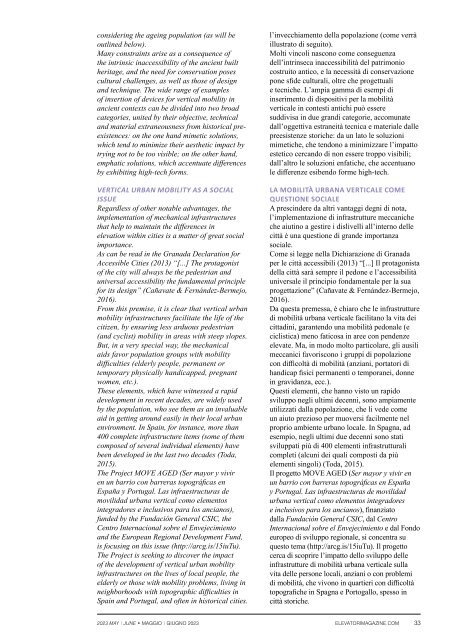Elevatori Magazine 3-2023
May - June 2023
May - June 2023
Create successful ePaper yourself
Turn your PDF publications into a flip-book with our unique Google optimized e-Paper software.
considering the ageing population (as will be<br />
outlined below).<br />
Many constraints arise as a consequence of<br />
the intrinsic inaccessibility of the ancient built<br />
heritage, and the need for conservation poses<br />
cultural challenges, as well as those of design<br />
and technique. The wide range of examples<br />
of insertion of devices for vertical mobility in<br />
ancient contexts can be divided into two broad<br />
categories, united by their objective, technical<br />
and material extraneousness from historical preexistences:<br />
on the one hand mimetic solutions,<br />
which tend to minimize their aesthetic impact by<br />
trying not to be too visible; on the other hand,<br />
emphatic solutions, which accentuate differences<br />
by exhibiting high-tech forms.<br />
VERTICAL URBAN MOBILITY AS A SOCIAL<br />
ISSUE<br />
Regardless of other notable advantages, the<br />
implementation of mechanical infrastructures<br />
that help to maintain the differences in<br />
elevation within cities is a matter of great social<br />
importance.<br />
As can be read in the Granada Declaration for<br />
Accessible Cities (2013) “[...] The protagonist<br />
of the city will always be the pedestrian and<br />
universal accessibility the fundamental principle<br />
for its design” (Cañavate & Fernández-Bermejo,<br />
2016).<br />
From this premise, it is clear that vertical urban<br />
mobility infrastructures facilitate the life of the<br />
citizen, by ensuring less arduous pedestrian<br />
(and cyclist) mobility in areas with steep slopes.<br />
But, in a very special way, the mechanical<br />
aids favor population groups with mobility<br />
difficulties (elderly people, permanent or<br />
temporary physically handicapped, pregnant<br />
women, etc.).<br />
These elements, which have witnessed a rapid<br />
development in recent decades, are widely used<br />
by the population, who see them as an invaluable<br />
aid in getting around easily in their local urban<br />
environment. In Spain, for instance, more than<br />
400 complete infrastructure items (some of them<br />
composed of several individual elements) have<br />
been developed in the last two decades (Toda,<br />
2015).<br />
The Project MOVE AGED (Ser mayor y vivir<br />
en un barrio con barreras topográficas en<br />
España y Portugal. Las infraestructuras de<br />
movilidad urbana vertical como elementos<br />
integradores e inclusivos para los ancianos),<br />
funded by the Fundación General CSIC, the<br />
Centro Internacional sobre el Envejecimiento<br />
and the European Regional Development Fund,<br />
is focusing on this issue (http://arcg.is/15iuTu).<br />
The Project is seeking to discover the impact<br />
of the development of vertical urban mobility<br />
infrastructures on the lives of local people, the<br />
elderly or those with mobility problems, living in<br />
neighborhoods with topographic difficulties in<br />
Spain and Portugal, and often in historical cities.<br />
l’invecchiamento della popolazione (come verrà<br />
illustrato di seguito).<br />
Molti vincoli nascono come conseguenza<br />
dell’intrinseca inaccessibilità del patrimonio<br />
costruito antico, e la necessità di conservazione<br />
pone sfide culturali, oltre che progettuali<br />
e tecniche. Lʼampia gamma di esempi di<br />
inserimento di dispositivi per la mobilità<br />
verticale in contesti antichi può essere<br />
suddivisa in due grandi categorie, accomunate<br />
dall’oggettiva estraneità tecnica e materiale dalle<br />
preesistenze storiche: da un lato le soluzioni<br />
mimetiche, che tendono a minimizzare l’impatto<br />
estetico cercando di non essere troppo visibili;<br />
dall’altro le soluzioni enfatiche, che accentuano<br />
le differenze esibendo forme high-tech.<br />
LA MOBILITÀ URBANA VERTICALE COME<br />
QUESTIONE SOCIALE<br />
A prescindere da altri vantaggi degni di nota,<br />
l’implementazione di infrastrutture meccaniche<br />
che aiutino a gestire i dislivelli all’interno delle<br />
città è una questione di grande importanza<br />
sociale.<br />
Come si legge nella Dichiarazione di Granada<br />
per le città accessibili (2013) “[...] Il protagonista<br />
della città sarà sempre il pedone e l’accessibilità<br />
universale il principio fondamentale per la sua<br />
progettazione” (Cañavate & Fernández-Bermejo,<br />
2016).<br />
Da questa premessa, è chiaro che le infrastrutture<br />
di mobilità urbana verticale facilitano la vita dei<br />
cittadini, garantendo una mobilità pedonale (e<br />
ciclistica) meno faticosa in aree con pendenze<br />
elevate. Ma, in modo molto particolare, gli ausili<br />
meccanici favoriscono i gruppi di popolazione<br />
con difficoltà di mobilità (anziani, portatori di<br />
handicap fisici permanenti o temporanei, donne<br />
in gravidanza, ecc.).<br />
Questi elementi, che hanno visto un rapido<br />
sviluppo negli ultimi decenni, sono ampiamente<br />
utilizzati dalla popolazione, che li vede come<br />
un aiuto prezioso per muoversi facilmente nel<br />
proprio ambiente urbano locale. In Spagna, ad<br />
esempio, negli ultimi due decenni sono stati<br />
sviluppati più di 400 elementi infrastrutturali<br />
completi (alcuni dei quali composti da più<br />
elementi singoli) (Toda, 2015).<br />
Il progetto MOVE AGED (Ser mayor y vivir en<br />
un barrio con barreras topográficas en España<br />
y Portugal. Las infraestructuras de movilidad<br />
urbana vertical como elementos integradores<br />
e inclusivos para los ancianos), finanziato<br />
dalla Fundación General CSIC, dal Centro<br />
Internacional sobre el Envejecimiento e dal Fondo<br />
europeo di sviluppo regionale, si concentra su<br />
questo tema (http://arcg.is/15iuTu). Il progetto<br />
cerca di scoprire l’impatto dello sviluppo delle<br />
infrastrutture di mobilità urbana verticale sulla<br />
vita delle persone locali, anziani o con problemi<br />
di mobilità, che vivono in quartieri con difficoltà<br />
topografiche in Spagna e Portogallo, spesso in<br />
città storiche.<br />
<strong>2023</strong> MAY | JUNE • MAGGIO | GIUGNO <strong>2023</strong><br />
ELEVATORIMAGAZINE.COM<br />
33













